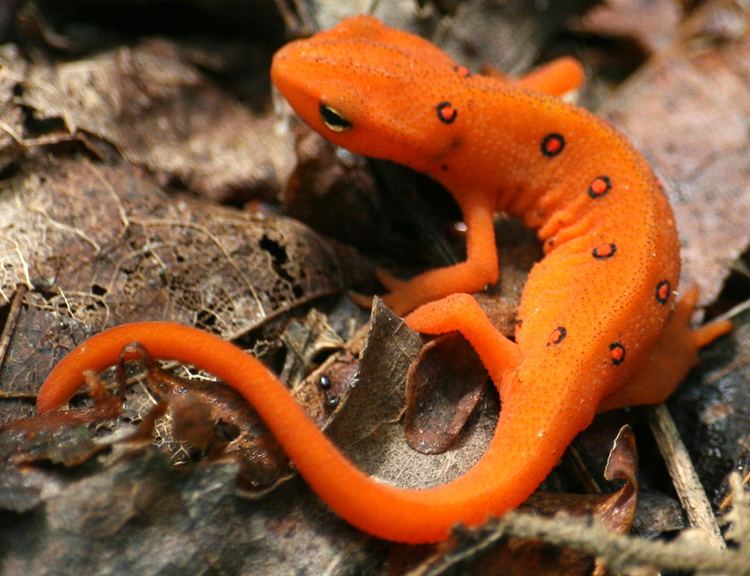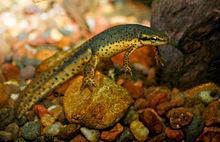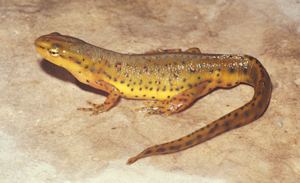Order Urodela Rank Species | Phylum Chordata Scientific name Notophthalmus viridescens Higher classification Notophthalmus | |
 | ||
Similar Notophthalmus, Salamander, Amphibians, Newt, Spotted salamander | ||
Amphibian exam eastern newt life cycle avi
The eastern newt (Notophthalmus viridescens) is a common newt of eastern North America. It frequents small lakes, ponds, and streams or near-by wet forests. The eastern newt produces tetrodotoxin which makes the species unpalatable to predatory fish and crayfish. It has a lifespan of 12 to 15 years in the wild, and may grow to five inches in length. These animals are common aquarium pets, being either collected from the wild or sold commercially. The striking bright orange juvenile stage, which is land-dwelling, is known as a red eft. Some sources blend the general name of the species and that of the red-spotted newt subspecies into eastern red-spotted newt (although there is no "western" one).
Contents
- Amphibian exam eastern newt life cycle avi
- Sub species
- Life stages
- Larva
- Red eft
- Adult
- Homing
- Habitat and diet
- References

Sub-species
The eastern newt includes these four subspecies:
Life stages

Eastern newts have three stages of life: (1) the aquatic larva or tadpole, (2) the red eft or terrestrial juvenile stage, and (3) the aquatic adult.
Larva

The larva possesses gills and does not leave the pond environment where it was hatched. Larvae are brown-green in color, and shed their gills when they transform into the red eft.
Red eft

The red eft (juvenile) stage is a bright orangish-red in color, with darker red spots outlined in black. An eastern newt can have as many as 21 of these spots. The pattern of these spots differs among the subspecies. During this stage, the eft may travel far, acting as a dispersal stage from one pond to another, ensuring outcrossing in the population. The striking coloration of this stage is an example of aposematism — or "warning coloration" — which is a type of antipredator adaptation in which a "warning signal" is associated with the unprofitability of a prey item (i.e., its toxicity) to potential predators.
Adult
After two or three years, the eft finds a pond and transforms into the aquatic adult. The adult's skin is a dull olive green dorsally, with a dull yellow belly, but retains the eft's characteristic black-rimmed red spots. It develops a larger, blade-like tail and characteristically slimy skin.
It is common for the peninsula newt (N. v. piaropicola) to be neotenic, with a larva transforming directly into a sexually mature aquatic adult, never losing its external gills. The red eft stage is in these cases skipped.
Homing
Eastern newts home using magnetic orientation. Their magnetoreception system seems to be a hybrid of polarity-based inclination and a sun-dependent compass. Shoreward-bound eastern newts will orient themselves quite differently under light with wavelengths around 400 nm than light with wavelengths around 600 nm, while homing newts will orient themselves the same way under both short and long wavelengths. Ferromagnetic material, probably biogenic magnetite, is likely present in the eastern newt's body.
Habitat and diet
Eastern newts are at home in both coniferous and deciduous forests. They need a moist environment with either a temporary or permanent body of water, and thrive best in a muddy environment. During the eft stage, they may travel far from their original location. Red efts may often be seen in a forest after a rainstorm. Adults prefer a muddy aquatic habitat, but will move to land during a dry spell. Eastern newts have some amount of toxins in their skin, which is brightly colored to act as a warning. Even then, only 2% of larvae make it to the eft stage. Some larvae have been found in the pitchers of the carnivorous plant Sarracenia purpurea.
Eastern newts eat a variety of prey, such as insects, small mollusks and crustaceans, young amphibians, worms, and frog eggs.
